Text

She had blond hair, high cheekbones, and wore clothing reminiscent of ancient Celts—yet she was found buried beneath the sands of China’s vast Taklamakan Desert. Known as the Beauty of Loulan, this remarkably well-preserved mummy is over 3,800 years old, and her discovery has rewritten what we thought we knew about early migration, trade, and cultural exchange.
Unearthed in the early 1980s near Loulan, in the Xinjiang region of western China, the mummy shocked archaeologists. Not only was she astonishingly intact, but her facial features, braided blond hair, and woven wool garments seemed distinctly European. DNA testing later confirmed that she and other mummies from the region were of Western Eurasian origin—suggesting that people were moving across continents and connecting cultures far earlier than previously believed.
The Beauty of Loulan wasn’t alone. Hundreds of similar mummies have been discovered in the Tarim Basin, many with Caucasian features, Indo-European ancestry, and garments made from tartan-like fabrics. These findings point to the existence of ancient Indo-European-speaking peoples, possibly related to the Tocharians, who lived and traded along what would later become the Silk Road—long before it was formally established.
Their presence challenges the long-held belief that early China was culturally and ethnically isolated. Instead, it reveals a much more interconnected ancient world, where ideas, goods, and even people moved across great distances through harsh landscapes like the Taklamakan Desert.
Despite being thousands of years old, the Beauty of Loulan remains hauntingly human—her eyelashes still visible, her expression serene. She stands as a silent testament to forgotten journeys, lost cultures, and the complexity of early civilisation.
Follow for more History Facts!
#HistoricalFacts #HistoryFacts #USAHistory #TimeTravel #DidYouKnow #AncientChina #Mummies #LoulanBeauty #HumanMigration #LostCivilisations
Source: Historical Facts
Facebook
3 notes
·
View notes
Text
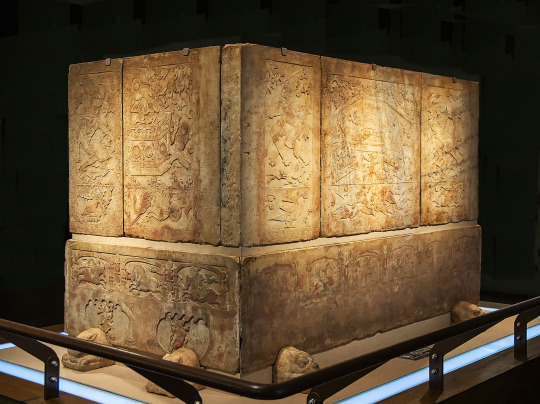
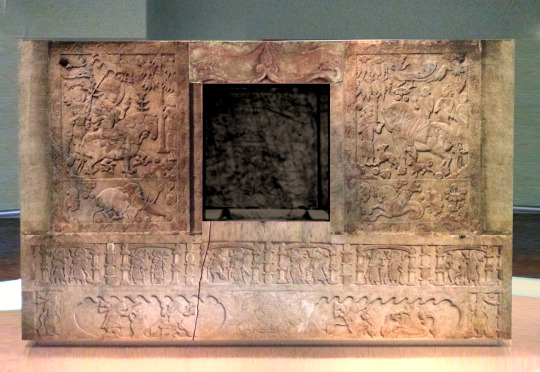
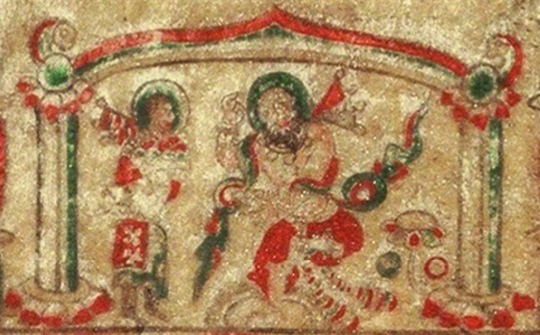
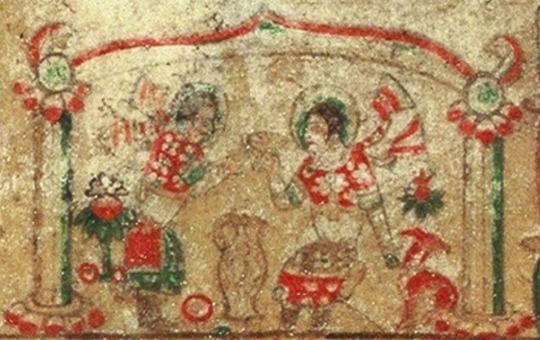
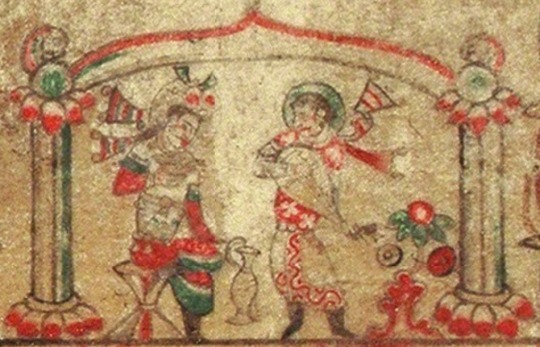
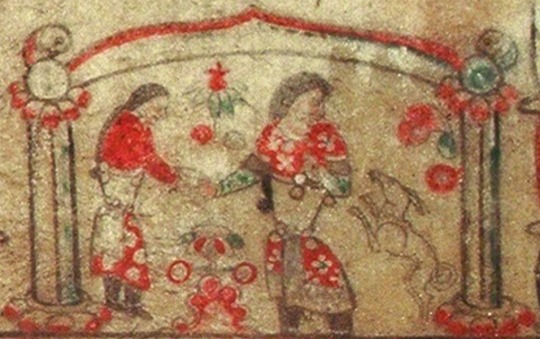


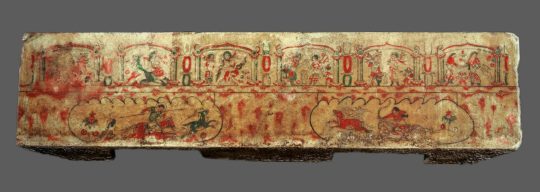
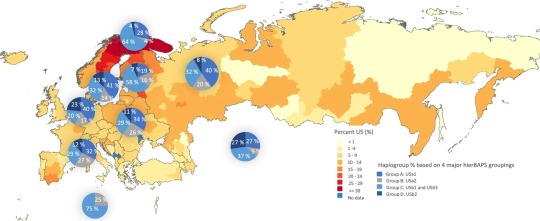

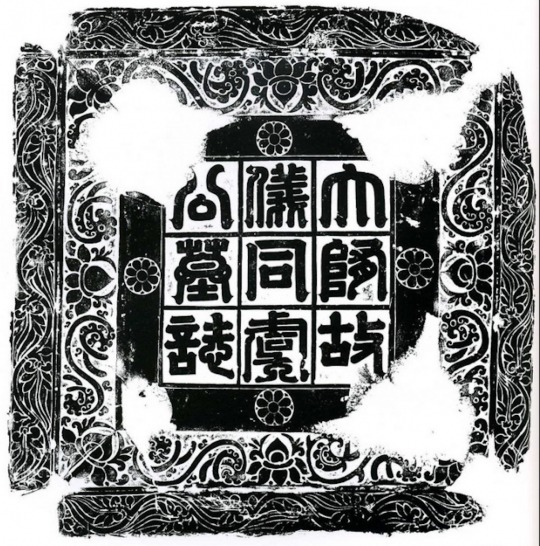
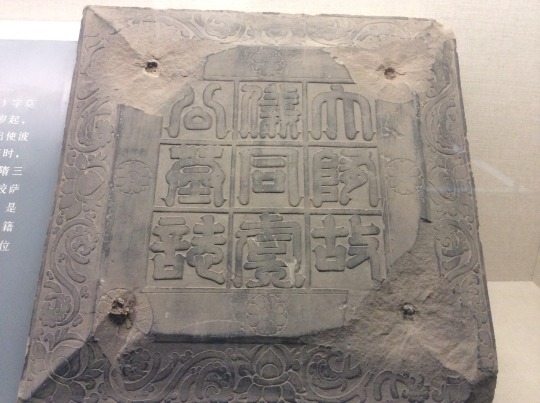

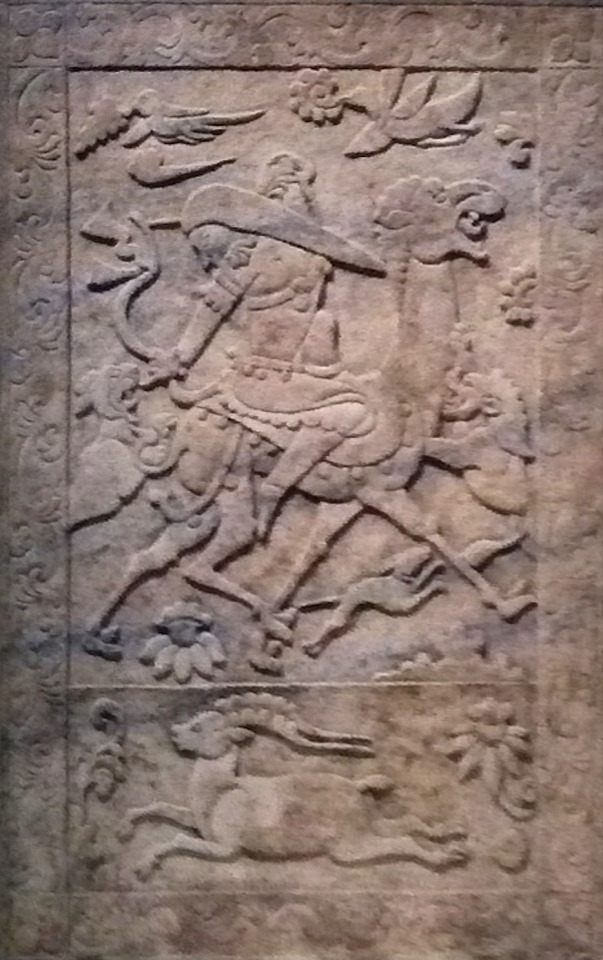
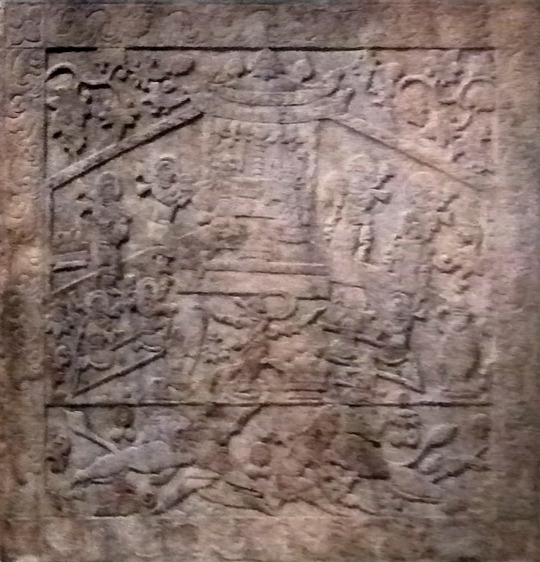


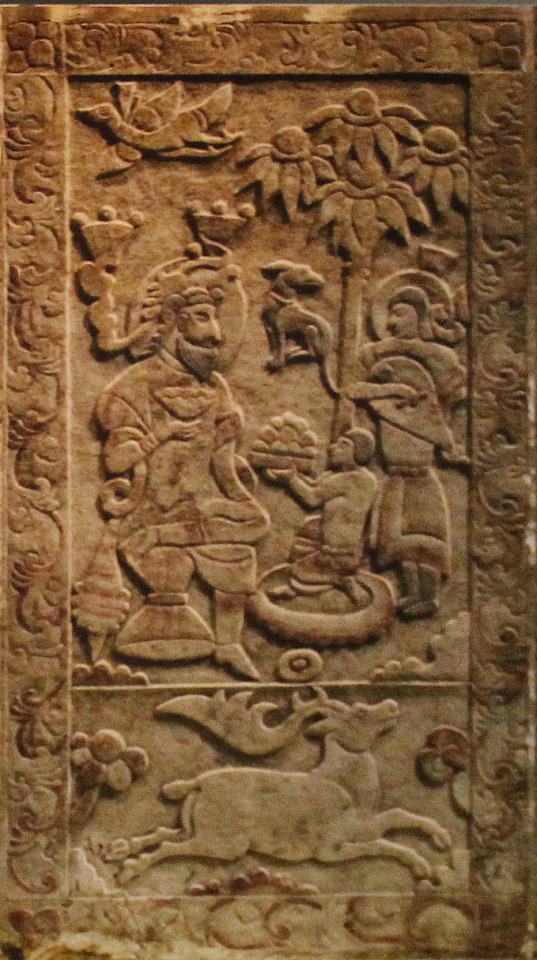
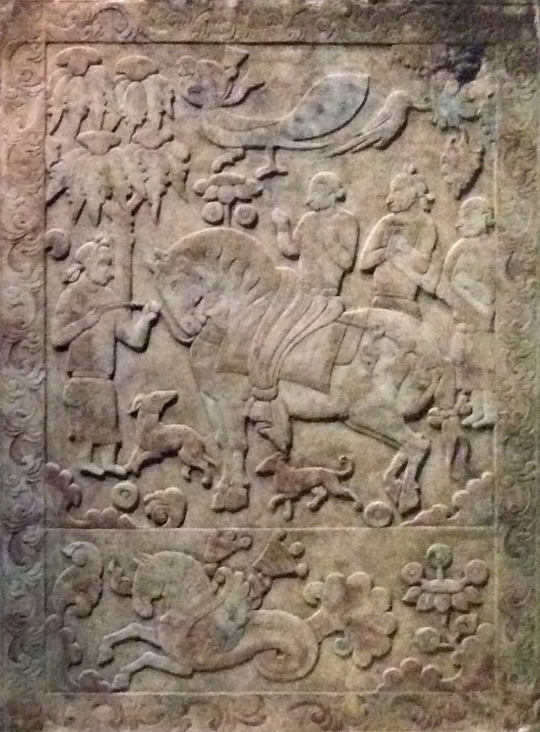
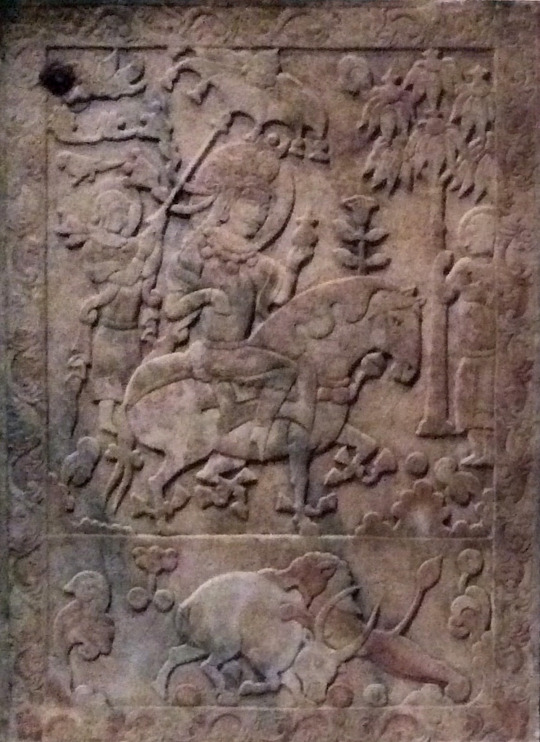
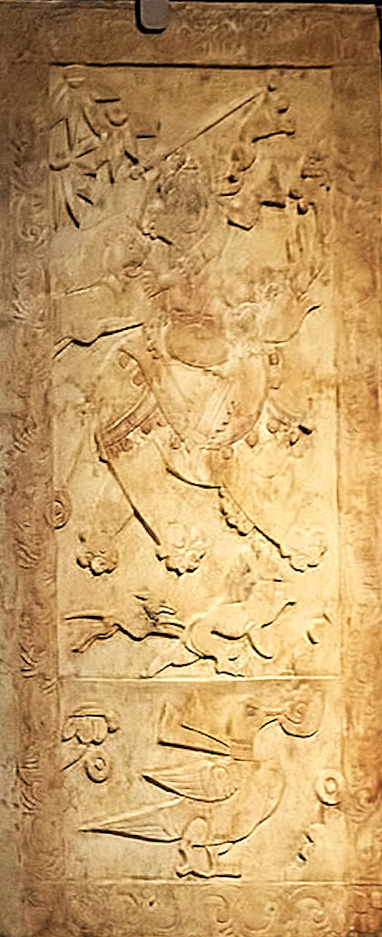
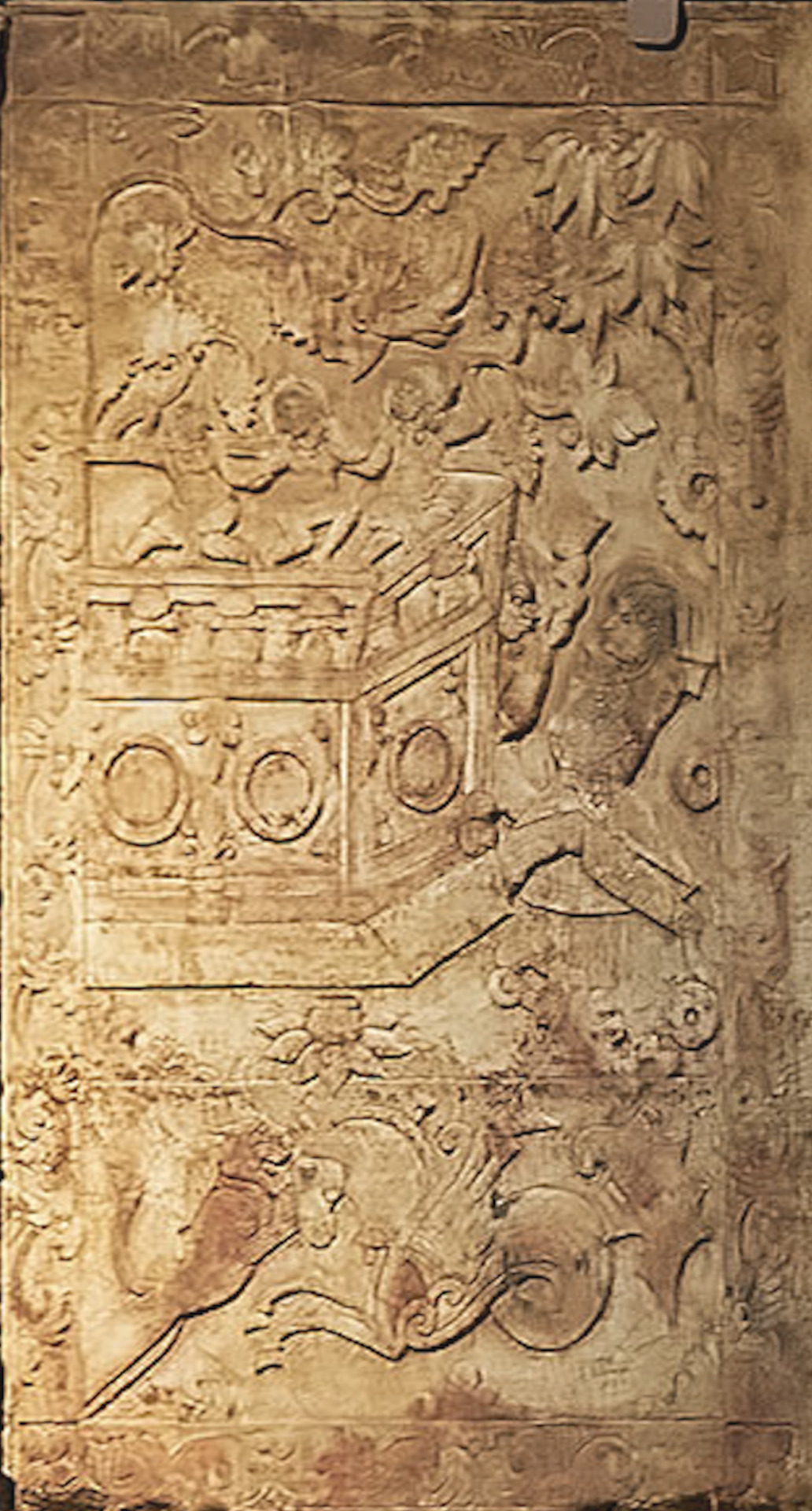



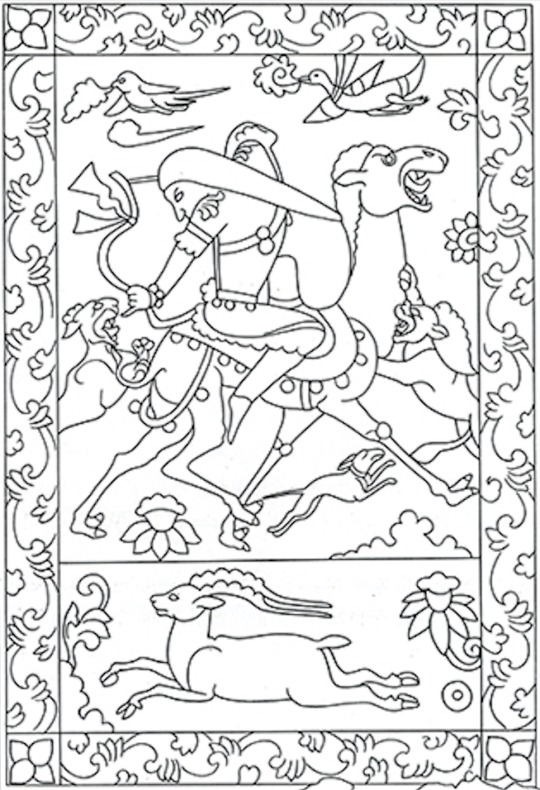
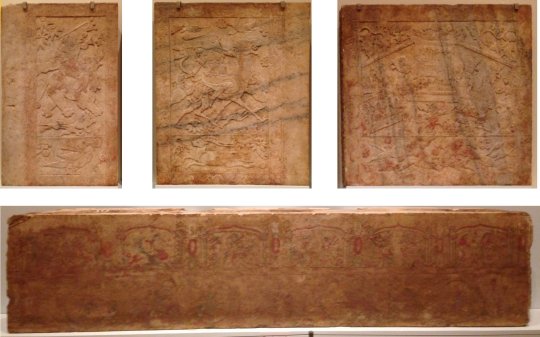


Tomb of Yu Hong 592-598 CE. Link to my blog at bottom with more sources and description of individual images.
This is probably a Sogdian tomb. Interestingly, the man has a haplogroup that was widespread amongst the blue-eyed Mesolithic/Neolithic Western Hunter Gatherers (WHG are probably where blue eyes originated from) and the haplogroup is found today most prominently in Sami, Finns, and Estonians. His wife has a haplogroup found prominently amongst East Asians. Based on her East Asian origins and the inclusion of some Turkic-looking people in the tomb's artwork I would assume she was probably a Turk, herself. The long-haired men without halos (e.g. panel 4) are probably Turks, that was a typical appearance for them during this time period. Men from other surrounding populations such as the Sogdians, Huns, Tocharians, etc. typically kept shorter hair that didn't go past their shoulders. More info:
"The man buried in the tomb went by Yu Hong (Chinese: 虞弘; pinyin: Yú Hóng; Wade–Giles: Yü Hung; 533–592 AD), with Mopan (莫潘) as his courtesy name, who was a Central Asian, probably of Persian or Sogdian origin, and practiced Zoroastrianism. He had settled in Early Middle Period China during the Northern Qi, Northern Zhou and Sui dynasties. This tomb is so far the only archaeological find in the Central Plains region that reflects Central Asian (Western Regions) culture. The epitaph found in the tomb records that he was a noble of the city of Yü-ho-lin / Yuhelin (尉紇驎) in the mysterious Yu country (魚國), assumably for which he is named, because the two characters 虞 and 魚 are homophones.
According to the epitaph, Yu Hong started his career in service of the nomadic tribe at the time, known as Ruru. At the age of 13, he was posted as an emissary to Persia by the Khagan of Ruru, as well as Parthia, Tuyuhun and Yuezhi. Later he went on a mission to the Northern Qi, Northern Zhou and Sui dynasties. He served as chien-chiao sa-pao fu / jianjiao sabao fu (檢校薩保府, lit. “acting director of the office of Zoroastrian affairs”, or “Sogdian affairs”) during the Northern Zhou period. The term sa-pao / sabao (薩保) comes from the Sogdian s′rtp′w, means a “caravan leader”.
He had later served as a provincial governor in the Sui dynasty government, a chieftain of the Central Asian people who had settled in China during that period. Yu Hong died at the age of 59 in 592 AD. His wife survived him by six years, and was buried in the same grave in 598 AD.
A study on ancient DNA reveals that Yu Hong belonged to the haplogroup U5, one of the oldest western Eurasian-specific haplogroups, while his wife can be classified as haplogroup G, the type prevalent in East Asia.
The age of U5 is estimated at between 25,000 and 35,000 years old, roughly corresponding to the Gravettian culture. Approximately 11% of Europeans (10% of European-Americans) have some variant of haplogroup U5.
U5 was the predominant mtDNA of mesolithic Western Hunter Gatherers (WHG) [this is where blue eyes probably originated from].
U5 has been found in human remains dating from the Mesolithic in England, Germany, Lithuania, Poland, Portugal, Russia, Sweden, France and Spain. Neolithic skeletons (~7,000 years old) that were excavated from the Avellaner cave in Catalonia, northeastern Spain included a specimen carrying haplogroup U5.
Haplogroup U5 and its subclades U5a and U5b today form the highest population concentrations in the far north, among Sami, Finns, and Estonians. However, it is spread widely at lower levels throughout Europe. This distribution, and the age of the haplogroup, indicate individuals belonging to this clade were part of the initial expansion tracking the retreat of ice sheets from Europe around 10,000 years ago.
U5 was the main haplogroup of mesolithic European hunter gatherers. U haplogroups were present at 83% in European hunter gatherers before influx of Middle Eastern farmer and steppe Indo-European ancestry decreased its frequency to less than 21%.
Today, haplogroup G is found at its highest frequency in indigenous populations of the lands surrounding the Sea of Okhotsk. It is an East Asian haplogroup. Haplogroup G is one of the most common mtDNA haplogroups among modern Ainu, Siberian, Mongol, Tibetan and Central and North Asian Turkic peoples people (as well as among people of the prehistoric Jōmon culture in Hokkaidō). It is also found at a lower frequency among many other populations of East Asia, Central Asia, Bangladesh, Sri Lanka, and Nepal. However, unlike other mitochondrial DNA haplogroups typical of populations of northeastern Asia, such as haplogroup A, haplogroup C, and haplogroup D, haplogroup G has not been found among indigenous peoples of the Americas."
-taken from Wikipedia
148 notes
·
View notes
Photo








Jeweled Skeletons From the 1600’s
‘Taken from the catacombs of Rome in the 17th century, the relics of twelve martyred saints were then attired in the regalia of the period before being interred in a remote church on the German/Czech border.’
- Immortal, Toby de Silva
4K notes
·
View notes
Text

All humans can trace their maternal ancestry back to a woman known as
"Mitochondrial Eve," who lived in Africa roughly 150,000 to 200,000 years ago.
She is the most recent female ancestor whose mitochondrial DNA has been passed down, unbroken, to every person alive today.
Source: Ancient History
Facebook
2 notes
·
View notes
Text
Source: Ancient History
Facebook

In the serene peat marshes of northern Germany, a shocking find in 1922 would alter our perceptions of Iron Age Europe forever. The remains of a young boy—referred to as the Kayhausen Boy—were uncovered from the protective grip of the bog, unveiling a narrative of violence that has intrigued archaeologists for over a hundred years. Dated to around 300-400 BCE, this seven-year-old's remains represent one of the most compelling mysteries in archaeology.
2 notes
·
View notes
Text

In the serene peat marshes of northern Germany, a shocking find in 1922 would alter our perceptions of Iron Age Europe forever. The remains of a young boy—referred to as the Kayhausen Boy—were uncovered from the protective grip of the bog, unveiling a narrative of violence that has intrigued archaeologists for over a hundred years. Dated to around 300-400 BCE, this seven-year-old's remains represent one of the most compelling mysteries in archaeology.
2 notes
·
View notes
Photo

Wolf skeleton dressed as a warrior, found with an atlatl, gold disk, and shell necklace. Found in an offering at the Templo Mayor, Mexico City. Aztec. Late 15th century.
https://twitter.com/friel/status/1199144334911791104/photo/1
10K notes
·
View notes
Text

A stunning discovery in Siberia has amazed scientists—a 42,000-year-old baby horse, known as the “Lena horse,” was found perfectly preserved in the frozen ground called permafrost. What makes this find so special is that the foal still had liquid blood and urine inside its body, something almost never seen in animals this old. The cold temperatures kept its body from breaking down over thousands of years. This ancient horse lived during the Ice Age, and its body gives scientists a rare chance to learn more about animals from that time. Even more exciting, the blood could help researchers study its DNA and maybe even try to bring back animals like it through cloning in the future. This little horse isn’t just a fossil—it’s a frozen piece of the past that could open the door to big discoveries about life long ago.
Source: Ancient History
Facebook
1 note
·
View note
Text
Just sitting here thinking to myself, it's only been 75 years since it became normal for parents not to bury their own children. It's only been about 3 generations since we mourned a quarter of our children. It's been a tiny sliver of a slice of the history of humanity since surviving your first 10 years was a coin flip

source
and I can't even imagine it. I cannot comprehend what it was like for 99.99% of history. How did they survive burying half of their children? I fully expect my own children to outlive me; it will be considered a rare, unexpected tragedy if they don't. How was this much misery normal for that much of history?
3K notes
·
View notes
Text

In 1879, deep within the peat bogs of Denmark, archaeologists made a shocking discovery—an ancient woman, perfectly preserved for over 2,000 years. Known as the Huldremose Woman, she offers an incredible glimpse into the past, her skin, hair, and clothing remarkably intact despite the passage of millennia.
Standing at over 40 years old, which was considered elderly in the Iron Age, the Huldremose Woman’s life ended in a way that still puzzles scholars. Her right arm had been severed with a sharp tool, suggesting she may have been a ritual sacrifice—a practice not uncommon in ancient Europe, where bogs were seen as sacred gateways between worlds.
But it’s her attire that truly tells her story. She wore a woolen skirt dyed blue, a red checked scarf, and two capes made from 11 lambskins. One cape even had 22 carefully sewn patches, symbolizing her high status in society. A bird-bone pin fastened her scarf, and a bone comb tucked into her garment hinted at protection and care.
Around her neck were two amber beads on a wool cord, adding to the mystery of her life. Her last meal? Ground rye, seeds, and animal tissue, offering a glimpse into her daily existence.
The exact reason for her death remains a mystery, but scholars believe she was sacrificed—a ritual that connected her to the spiritual world. Her story, preserved by the very earth that took her life, is a haunting reminder of the ancient rituals that once shaped our world.
#AncientRituals #BogBodies ~Forgotten Stories
4 notes
·
View notes
Text

Imagine uncovering the 7,200-year-old burial of a young woman deep within Leang Panninge cave on the Indonesian island of Sulawesi, only to discover that her DNA tells the story of a human lineage that has completely vanished. Preserved against the odds in the heat and humidity of the tropics, her genetic material revealed she belonged to the Toalean culture—a group of hunter-gatherers who roamed Sulawesi’s southwestern peninsula between 8,000 and 1,500 years ago. But what astonished researchers even more was the ancestry she carried within her bones. Her genome showed she was a distant relative of present-day Aboriginal Australians and Melanesians—peoples whose ancestors were among the first to cross into Oceania. She also bore traces of Denisovan DNA, linking her to that mysterious archaic hominin, a trait rare among other Southeast Asian groups today. This unexpected finding suggests that the islands of Wallacea were more than a passageway; they were a place where Homo sapiens and Denisovans may have interacted long before humans ever reached Australia, possibly as far back as 65,000 years ago. The discovery that her lineage branched off from other Oceanic populations at such an early stage opens a window into a forgotten chapter of human migration and contact. Although she died around the age of 18, her remains—especially the DNA extracted from her inner ear—carry a legacy that bridges lost peoples, ancient journeys, and deep ancestral ties that echo across the Pacific.
#leang panninge cave#Indonesian island of Sulawesi#7200 year old burial of young woman app 18 years old#archaeology#history#skeleton#dna
2 notes
·
View notes
Text

Windeby Girl. 41 BC and 118 AD.
Found near Windeby, Germany in 1952.
When the corpse of a teenage girl was found more than 50 years ago in a Germany bog, scholars immediately assumed that she, like other bog bodies they had seen before, was a victim of an unnatural death.
She appeared to have been blindfolded, and half her head had been shaved.
But the body of Windeby Girl shows no signs of trauma, and evidence from the skeleton suggests she may have died from repeated bouts of illness or malnutrition.
The woolen band probably slid down over her eyes as a result of the body's shrinkage, and had likely been used to hold her hair back or to cover her eyes after death.
And her "half-shaved" hair was probably the result of a natural process of decay from greater exposure to oxygen on one side of her head than the other, or of trowel damage caused during excavation.
It turned out a few years ago that this person might actually be a young man.
Source: Ancient History
Facebook
0 notes
Text

3,200-Year-Old Egyptian Tomb of Ramesses III’s Military Commander Uncovered
Egyptian archaeologists have discovered a 3,200-year-old tomb thought to be that of a senior military commander during the time of Pharaoh Ramesses III. The tomb was discovered at the Tell el-Maschuta site, also referred to as Tell el-Maskhuta, in the Ismailia governorate. The discovery illuminates the strategic significance of the area in protecting Egypt’s eastern borders during the New Kingdom period.
Dr. Mohamed Ismail Khaled, Supreme Council of Antiquities Secretary General, underlined the significance of the discovery, noting that the Tell el-Maschuta area was a key military outpost. Existing fortifications and garrisons in the region suggest that it played a crucial role in defending Egypt against external threats.
The tomb, constructed using mud bricks, features a main burial chamber and three other surrounding rooms whose walls are covered with white mortar. Inside, archaeologists discovered a collection of artifacts that indicate the deceased was a high-ranking military official. The most significant items discovered were a gold ring with the cartouche of Ramesses III, bronze arrowheads, and a small ivory box. The artifacts suggest the individual was the pharaoh’s military leader.



One of the most fascinating finds was a set of inscribed pottery vessels with the name of Pharaoh Horemheb, who reigned from around 1323 to 1295 BCE. A former military leader before becoming a pharaoh, Horemheb ruled over a hundred years prior to Ramesses III. The fact that his name appears on the pottery indicates that the tomb could have been reused over time.
Further evidence of the reuse of the tomb came to light through the human remains recovered inside. A skeleton covered in cartonnage—material made up of linen and plaster—refers to the fact that the burial had been altered in later periods. In addition to skeletal remains, archaeologists also recovered alabaster vessels, semi-precious stones, and amulets depicting the gods Taweret and Bes, as well as the Eye of Udjat, a protective symbol in Egyptian mythology.
Beyond the military commander’s tomb, archaeologists also uncovered a series of collective and individual burials dating to the Greco-Roman and Late Periods. These burials contained skeletal remains and funerary artifacts that highlight the region’s rich cultural history as a crossroads between civilizations. Professor Qutb Fawzi Qutb, director of the Lower Egypt and Sinai Antiquities Department, noted that the combination of Egyptian and Greco-Roman elements in the tombs provides valuable insights into the region’s diverse historical influences.



In addition to the tomb of the military commander, archaeologists also unearthed a series of collective and individual burials that dated to both the Greco-Roman and the Late Period. The burials contained skeletal remains and artifacts revealing the region’s rich cultural history as a crossroads between civilizations.
Ramesses III, who ruled from about 1184 to 1153 BCE during Egypt’s 20th Dynasty, is often regarded as the last great pharaoh of ancient Egypt. His reign was marked by military conflicts, most notably his conflicts with the Sea Peoples, a group of seafaring raiders that threatened the stability of Mediterranean civilizations. In the most pivotal battle, the Battle of the Delta in 1175 BCE, the Egyptian navy outmaneuvered the invaders with tactical superiority on the waterways of the Nile.
The recently discovered tomb brings intriguing speculations about the occupant’s role in these wars of antiquity. If this individual buried within was a military commander under Ramesses III, he may have played a crucial role in defending Egypt.
The Egyptian Tourism and Antiquities Ministry stated it would go ahead with more excavations and studies on the site in the hopes that further studies will reveal additional information on Egypt’s military and cultural history.
By Dario Radley.

25 notes
·
View notes
Text

Gooey Almond Croissant Cinnamon Rolls
#gooey#almond croissant#cinnamon rolls#cinnamon#rolls#almond#almond croissant cinnamon rolls#breakfast#nuts
237 notes
·
View notes
Text
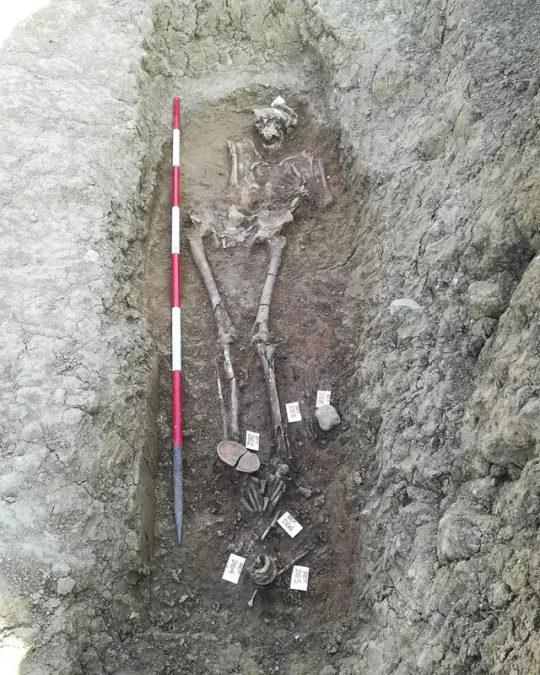
Imperial Roman Necropolis Found in Sicily
Archaeologists with the civil engineering company Italferr have unearthed a Roman settlement and necropolis during the construction of the new Palermo-Catania-Messina railway link in Sicily.
Located on a hill overlooking the Dittaino River, this Roman settlement dates back to the mid-1st to the 3rd century CE. The site’s strategic position, offering control over the Dittaino Valley and key communication routes, underscores its importance during its time.

Excavations have revealed a well-organized rustic villa complex, known as a villa rustica, which was central to the settlement’s agricultural and livestock activities. The villa’s central room, flanked by three ambulatories, has been identified through traces of collapsed roof materials. The villa’s remains indicate not only a residential function but also a productive role, likely linked to the region’s agricultural economy. Remnants of pavements and collapsed structures further emphasize the villa’s significance.
To the west of the settlement lies an extensive necropolis with 168 burials, showcasing a highly stratified society. The burials range from simple earth pits covered with tiles to monumental tombs, indicating significant social diversity within the community.

Among the notable graves is a bastum, or mound grave, which contained exceptional funerary offerings, including five necklaces, two gold rings, and a cinerary urn made from Carrara marble.
The urn bears an inscription dedicated to a “Magnus Magister Pecoris,” an official responsible for overseeing sheep breeding, and another inscription mentioning a “dispensator” who donated the urn to the deceased.
Magnetometric surveys to the east of the settlement have identified a possible cult area. Archaeologists found traces of burnt animal bones, ash layers, and alluvial deposits in a natural channel, indicating ritual activities. Among the recovered objects are oscilla masks, bone needles and pins, and a die with an undeciphered inscription. These artifacts suggest the performance of rituals and offerings to various deities in connection with festivals and ceremonies.
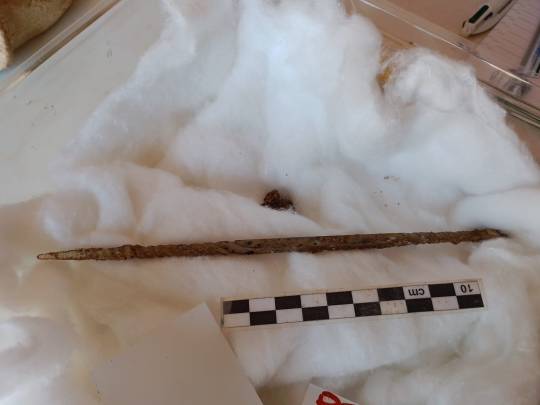
Italferr, a company under the Ferrovie dello Stato Italiane Group, has been at the forefront of integrating archaeological expertise with modern engineering practices since the 1990s. The company’s proactive approach to preventive archaeological investigations has proven instrumental in preserving cultural heritage while advancing infrastructure development.
The excavations at the Palomba-Catenanuova section began in 2020 in collaboration with the Soprintendenza Beni Culturali e Ambientali di Enna.
By Dario Radley.


189 notes
·
View notes
Text
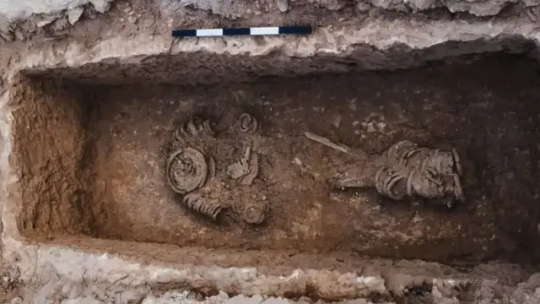
1,500-Year-Old Skeleton Found in Chains in Jerusalem was a Female 'Extreme Ascetic'
Not far from Jerusalem, archaeologists have discovered the fifth-century burial of a person wrapped in heavy metal chains. But the Byzantine-era grave held another surprise: The person who had practiced religious bodily punishment was female.
Excavations of a series of crypts at the Byzantine monastery at Khirbat el-Masani, about 1.9 miles (3 kilometers) northwest of the Old City of Jerusalem, revealed the skeletons of several men, women and children. One tomb contained the poorly preserved bones of an individual wrapped in chains. The corpse was not constrained for nefarious reasons, archaeologists suggested. Rather, the chains were used by the person during life to limit mobility as a part of a religious ascetic lifestyle. Initially, the Israel Antiquities Authority, which oversaw the dig, reported that this individual was male.
After Christianity became the main religion of the Roman Empire in A.D. 380, there was a surge of new monasteries and asceticism, in which monks abstained from worldly pleasures for spiritual purposes. A common practice of asceticism involved living at the top of a pillar while preaching and praying, often with heavy chains worn around the body.
In a study published in the April issue of the Journal of Archaeological Science: Reports, researchers studied the bones in the chain-filled burial with the goal of confirming the person was male. But they got a big surprise: the person was probably female.
"The use of chains by male ascetics is widely documented," study co-author Elisabetta Boaretto, an archaeologist at the Weizmann Institute of Science in Israel, told Live Science in an email, but "it's much rarer to find accounts of women using chains in the same way."
The person appeared to be between 30 and 60 years old at the time of death, but the bones were poorly preserved. So the researchers analyzed peptides — short chains of amino acids — in the person's tooth enamel to figure out their sex.


They found the presence of AMELX, an X-chromosome gene involved in enamel development, but no evidence of AMELY, the Y-chromosome gene that codes for the same thing. This meant the person very likely had two X chromosomes and was female.
"It is important to note that our results only show biological sex identification and not gender preference," the researchers wrote in the study.
Female ascetics are known from historical records, the study authors said, particularly among nobility starting in the fourth century. However, women in ascetic communities tended to pursue their spiritual paths in different ways that were generally less extreme than those practiced by men, Boaretto said. Prayer, fasting and meditation were more likely to be integral to women's spiritual journeys.
As physical restraints, chains were a more extreme way to practice asceticism, Boaretto said, as they were meant to keep the body in check and the spirit focused. "By restricting their physical movements, they created space for their minds and hearts to turn solely to God," she said.
Although other chained burials of ascetics have been discovered in the past, the identification of a woman buried in this way is highly unusual.
"The chains were likely viewed as integral to her identity as an ascetic," Boaretto said, and her burial "may have served to honor her ascetic life and ensure that her spiritual commitment continued to be recognized even after death."
By Kristina Killgrove.

39 notes
·
View notes
Text

The Screaming Woman Mummy
The screaming woman mummy was discovered beneath Theban Tomb 71, the burial site of Senmut's relatives, the architect of 18th-Dynasty Queen Hatschepsut (1479-1458 BC).
The excavation notes (1935-1936):
Condition: A well-preserved mummy. Skin all present tanned hard and thick, and a deep reddish brown in color. White mold around legs and feet and over breast. Finger and toenails preserved.
Eyes tight closed. Vagina open, mouth wide-open.
Mummification: Thoroughly "cured" (skin tanned) in a (salt) solution and drenched in a dark oily liquid preservative. Neither brains nor viscera removed (nose closed still; no incision anywhere on body). Sex; Female. Age: Elderly adult.
Hair: (on crown of head) Thin, fairly long, slightly wavy; now pale yellowish brown in color probably white or gray at time of death.
False hair: on either side of the head, braided to the woman's own sparse hair at either side of the crown of the skull, a long heavy roll or switch, composed of fine braids of very dark brown human hair (tapering in slightly at each end, the lower ends whipped with loose strands of hair).
Source: Front. Med., 01 August 2024, Sec. Pathology, Volume 11
- 2024
Source: Ancient history
2 notes
·
View notes